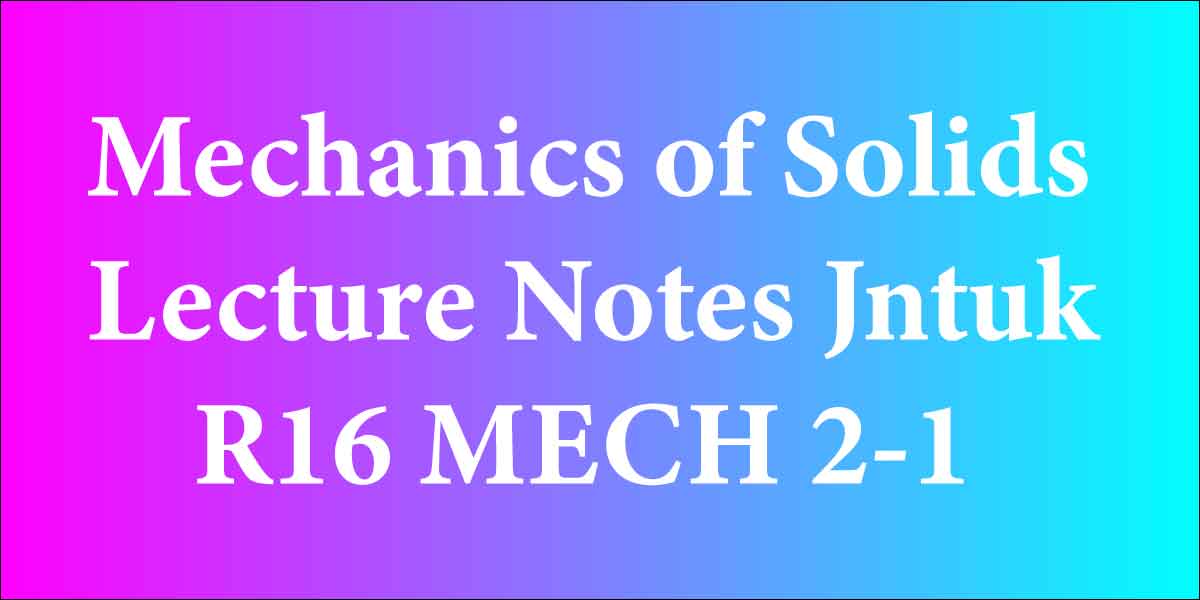Mechanics of Solids
Common to Mechanical, natural philosophy & Automobile Engineering.
Objective:
the scholars finishing this course area unit expected to know the fundamental terms like stress, strain, poissons ratio…etc and totally different stresses evoked in beams, skinny cylinders, thick cylinders, columns. Further, the coed shall be ready to perceive the shear stresses in circular shafts.
UNIT – I
Objective: once learning this unit student can recognize the fundamental terms like stress, strain poissons ratio…etc and stresses in bars of variable cross sections, composite bars, thermal stress in members, stresses on inclined planes with analytical approach and graphical approach, strain energy underneath totally different loadings and additionally drawback determination techniques. easy STRESSES & STRAINS : snap and physical property – forms of stresses & strains–Hooke’s law – stress – strain diagram for low-carbon steel – operating stress – issue of safety – Lateral strain, Poisson’s magnitude relation strain – Bars of variable section – composite bars – Temperature stresses- complicated Stresses – Stresses on AN simple machine underneath totally different uniaxial and biaxate stress conditions – Principal planes and principal stresses – Mohr’s circle – Relation between elastic constants, Strain energy – Resilience – Gradual, sudden, impact and shock loadings.
UNIT – II
Objective: once learning this unit students can recognize the development of shear force diagrams and bending moment diagrams to the various hundreds for the various support arrangements and additionally drawback determination techniques. SHEAR FORCE AND BENDING MOMENT : Definition of beam – forms of beams – conception of shear force and bending moment – S.F and B.M diagrams for cantilever, merely supported and overhanging beams subjected to purpose hundreds, u.d.l, uniformly variable hundreds and combination of those hundreds – purpose of contra flexure – Relation between S.F., B.M, and rate of loading at a district of a beam.
UNIT – III
Objective: once learning this unit students can recognize the bending and shear stress evoked within the beams that area unit created with totally different cross sections like rectangular, circular, triangular, I, T angle sections and additionally drawback determination techniques. FLEXURAL STRESSES : Theory of easy bending – Assumptions – Derivation of bending equation: M/ I = f/y = E/R Neutral axis – Determination bending stresses – section modulus of rectangular and circular sections (Solid and Hollow), I,T, Angle and Channel sections – style of easy beam sections. SHEAR STRESSES: Derivation of formula – Shear stress distribution across varied beams sections like rectangular, circular, triangular, I, T angle sections.
II Year – I Semester
L T P C
4 0 0 3
MECHANICS OF SOLIDS
UNIT – IV
Objective: once learning this unit students can knowledge to finding slope and deflection for various support arrangements by Double integration methodology, Macaulay’s methodology and Moment-Area and additionally drawback determination techniques. DEFLECTION OF BEAMS: Bending into a circular arc – slope, deflection and radius of curvature – equation for the elastic line of a beam – Double integration and Macaulay’s ways – Determination of slope and deflection for cantilever and easily supported beams subjected to purpose hundreds, – U.D.L uniformly variable load. Mohr’s theorems – Moment space methodology – application to easy cases as well as overhanging beams, Statically Indeterminate Beams and answer ways.
UNIT – V
Objective: once learning this unit student can knowledge a cylinder fails, what reasonably stresses evoked in cylinders subjected to internal, external pressures and additionally drawback determination techniques. skinny CYLINDERS: skinny seamless cylindrical shells – Derivation of formula for longitudinal and circumferential stresses – hoop, longitudinal and meter strains – changes in DIA, and volume of skinny cylinders – Riveted boiler shells – skinny spherical shells. THICK CYLINDERS: –lame’s equation – cylinders subjected to within & outside pressures –compound cylinders.
UNIT –VI
Objective: once learning this unit student can recognize shear stresses evoked in circular shafts, discussing columns in stability purpose of read and columns with totally different finish conditions. TORSION: Introduction-Derivation- Torsion of Circular shafts- Pure Shear-Transmission of power by circular shafts, Shafts serial, Shafts in parallel. COLUMNS: Buckling and Stability, Columns with stapled ends, Columns with alternative support Conditions, Limitations of Euler’s Formula, Rankine’s Formula,
Text Books:
- Strength of materials /GH Ryder/ Mc Millan publishers India Ltd
- Solid Mechanics, by Popov
- Mechanics of Materials/Gere and Timoshenko, CBS Publishers
- References :
- Strength of Materials -By Jindal, Umesh Publications.
- Analysis of structures by Vazirani and Ratwani.
- Mechanics of Structures Vol-III, by S.B.Junnarkar.
- Strength of Materials by S.Timoshenko
- Strength of Materials by St. Andrew Pytel and Ferdinond L. Singer Longman.

